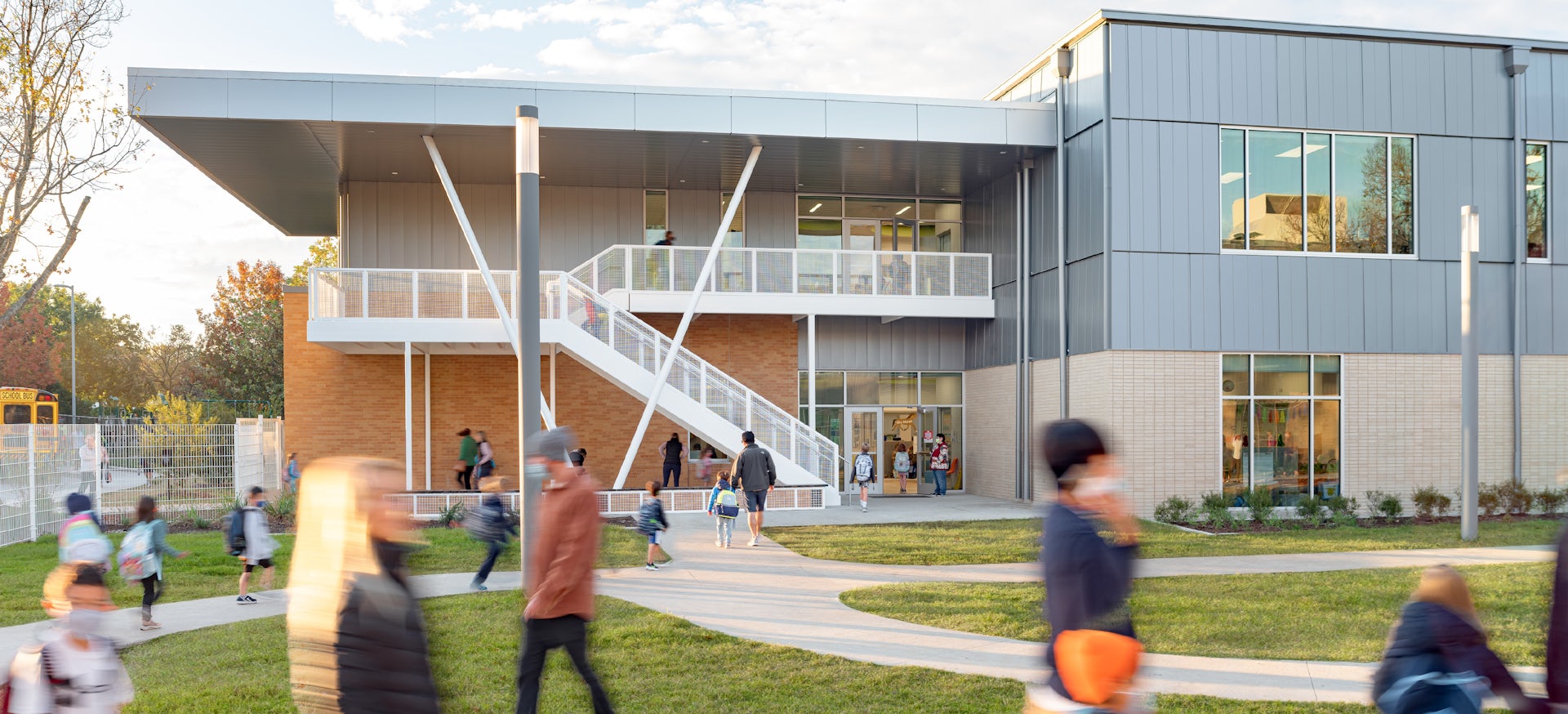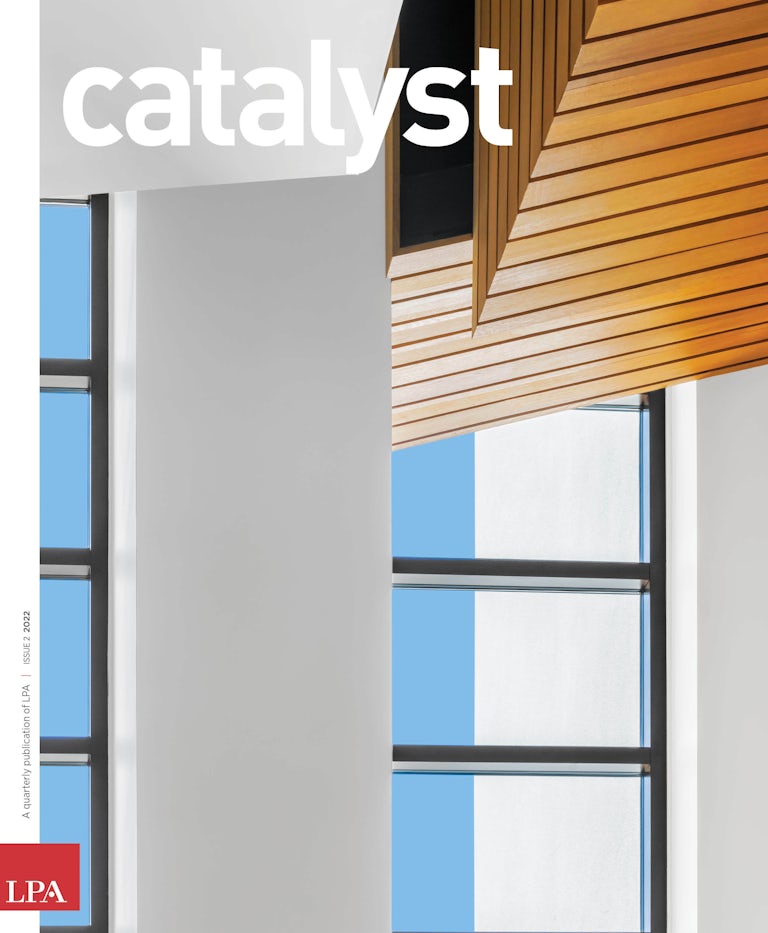An Austin elementary school was redesigned around preserving the school’s connections to the outdoors and the community.
During early discussions about the redevelopment of Casis Elementary, a 69-year-old campus in Austin, Texas, faculty and students spoke passionately about the importance of connecting to nature.
In particular, they emphasized their love for an outdoor classroom and garden, stuck on the edge of the campus across the parking lot from classrooms. Designed pro bono by Baldridge Architects and built by University of Texas School of Architecture students, the steel-and-white-mesh pavilion was a popular spot for classes, garden projects and hanging out.
“The design inspiration for the new school started with that outdoor garden,” says LPA Director of K-12 Kate Mraw.
The new Casis replaces the aging campus with a modern, 93,000-square-foot school designed to support the district’s learning initiatives and maintain long-standing connections between the school, community and nature. Learning environments are shaped around collaboration spaces and flexible work areas, as well as connections to the outdoor spaces that have been part of the campus for decades. The steel-and-white-mesh classroom, one of the few elements salvaged from the original campus, was moved to a key location next to a neighboring grove of trees known as the Casis Forest, serving as a link to the trees and the school’s unique history.
Casis plays a unique role in the community. In addition to setting high academic standards, the school provides facilities and instruction for special education and advanced technology.
The school embraced outdoor learning long before it was fashionable. Generations of residents attended the school and played an active role in its growth. Over the years, parents built play and study areas in the forest, planted trees and helped students create gardens.
The new design was developed through an extensive engagement process with parents, teachers and students, with a Campus Architectural Team involved in every step of the design process. Every phase included community engagement that encompassed surveys, open house events, visual listening activities and design workshops. In one workshop, teachers were asked to map a day in the life of a student in 2030.
“LPA are great listeners,” Casis Principal Sam Tinnon says. “They really work to understand us first, before sharing their design ideas.”
Students were involved throughout the process. Designers staged a session with more than 700 students, gathering input on what they would like to see in their new school. Groups of students worked together to develop ideas. One group built a stage in their maker space with the idea of inviting local businesses to come in and brainstorm concepts to help the community; another suggested building a bridge to the forest.
“All of this told us that students are deep thinkers, empathetic beings and passionately creative and that the spaces we design have to support their sense of wonder and exploration,” Mraw says.
The first phase of the new campus, opened in 2021, features a pair of two-story buildings connected on the second floor by a learning deck. The addition of the second floor preserved open space and the original flow of the campus, while addressing the educational goals. The design builds on Austin ISD’s specifications for next-generation learning, creating a series of small group rooms, maker spaces and open areas to support different types of teaching. Instead of co-locating the collaboration spaces in one area, designers dispersed gathering spots throughout the learning villages. Collaboration spaces are designed for transparency, flexibility and the connection to nature.
“The idea was really to strengthen the connections between this gift of the site and the gift of learning and that inspiration,” Mraw says.
The design maintains the school’s traditional connections to the outdoors, recognizing the school’s focus on outdoor learning. The buildings are oriented to maximize natural light and the connection to the trees. Deck areas and patios are linked to classrooms; outdoor spaces are designed to support activities and spark imagination.
“We maintained the series of outdoor courtyards in a similar way with different scales and different functions,” says LPA Project Architect Jim Oppelt. “The outdoor spaces are grouped to make them very accessible to each group of teaching and learning spaces.”
The orientation of the campus maintains the school’s connection to the retail center across the street, Casis Village, which was an important priority for the community. Paths on three sides of the campus were designed to accommodate the large number of students who walk and bike to school.
“It’s not about turning your back on the neighborhood,” Mraw says. “It was really about showing the community all the joy and excitement that is happening on campus.”
Building the new campus on the small site with minimal class disruption required a detailed phasing plan, developed with the school and Joeris General Contractors. All classrooms were incorporated into the first phase, with the library and administration spaces to follow. The existing library and gym remained open during first-phase construction and then were demolished at the start of the second phase. An interim library was created in the new classroom building in space that will ultimately be the maker space for the technology center, with sliding glass doors that open to a backyard deck and the front courtyard.
When the school opened, students immediately felt comfortable in the new surroundings, Tinnon says. The preservation of the outdoor garden, the trees and the basic organization of the campus helped ease the transition, he says. Students quickly embraced the new learning environments and put them to use.
“Our whole school has such a natural flow from the inside of the building to the outside of the building,” Tinnon says. “It’s really exciting how the spaces are used in so many different ways.”
The deck connecting the two buildings has become one of the most popular spots on campus. It’s used for yoga classes, events and classes. The Parent Teacher Association has plans to contribute funds to add furniture and resources for students on the deck. “The deck makes us feel that we are using every single part of our school,” Tinnon says.
The familiar feeling of the campus has been important to students and the community, who feared that the campus might lose its historic presence in the neighborhood. Instead, the new campus fits right in to the neighborhood, while delivering the modern learning environments required by the district.
“It’s amazing that we have this brand-new building, but we still have the outside access and activities that we’ve always had,” Tinnon says. “It makes for an engaging, fun and comfortably familiar environment for the kids and teachers.”






















